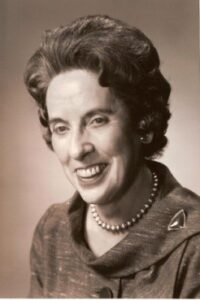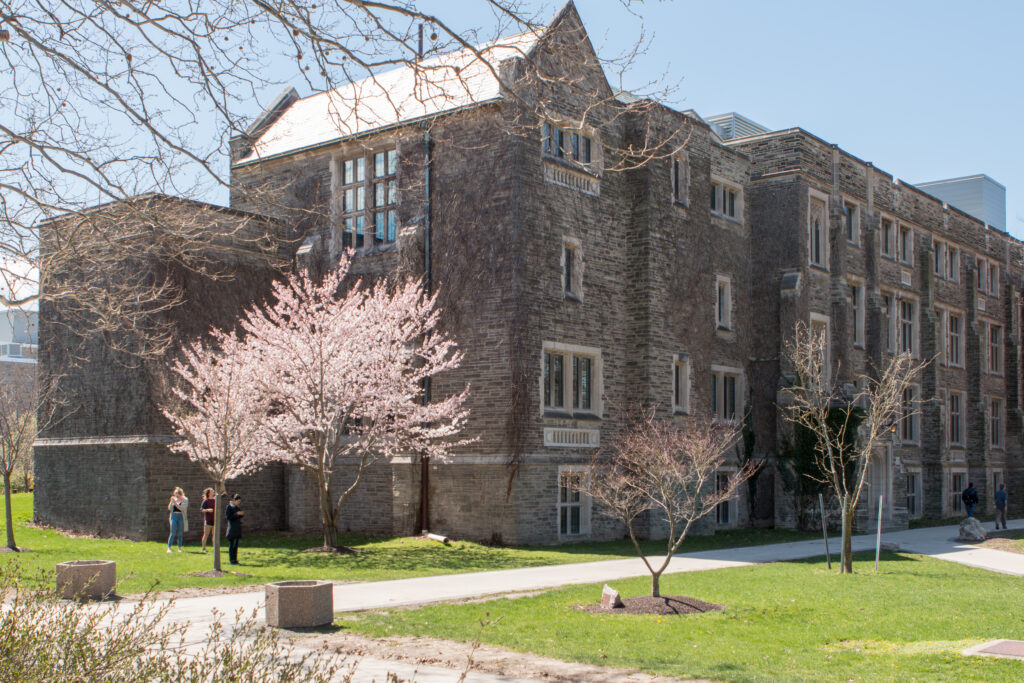About
WHERE WE BEGAN
The School of Nursing at McMaster began when Miss Constance Brewster, Superintendent of Nurses and Director of the School of Nursing at Hamilton General Hospital (HGH), 1934-1963, thought that there were opportunities available for academically trained nurses. She contacted Dr. Burke, Dean of Science at McMaster University and suggested that some of McMaster’s graduates might be interested in entering the nursing school after their graduation.

“ARTS COURSE AND NURSE’S TRAINING” LAUNCHED
In 1940, three graduates enrolled at the HGH School of Nursing. However, seven years of schooling (four at McMaster and three at HGH) was a long time, and there were few applicants. A Joint Committee was convened to investigate the problem resulting in a combined course for nurses, covering a B.A. and nursing training at the Hamilton General Hospital for a total of five years. The “Arts Course and Nurse’s Training” was first offered in the 1941-1942 term. Three women enrolled the first year. However, the programme only lasted 3 years with 8 graduates in total.
SCHOOL OF NURSING ESTABLISHED AS PART OF HEALTH SCIENCES FACULTY
In 1946-1947, McMaster was ready to try again. Miss Gladys Sharp was hired as the first director in 1946 to lay down the foundations for a nursing education programme, create a plan, and construct a curriculum. In November 1946, the School of Nursing was accredited by the Nurses Registration Act of Ontario. Sharp created the first McMaster curriculum. Following Miss Sharp’s appointment completion, Alma Reid began in 1948.
In 1974 the School of Nursing became part of the newly-created Faculty of Health Sciences and moved into the McMaster University Medical Centre. Graduates receive a Bachelor of Science in Nursing (BScN) degree .
HISTORY OF GRADUATE PROGRAMS AT MCMASTER
The first graduate courses designed for nursing students at McMaster were part of an interdisciplinary clinical Master’s of Health Sciences (MHSc), which started in 1973. It included the departments of occupational therapy and physiotherapy and the school nursing. The MHSc program was housed within the school of nursing. The MHSc was a fast-track to a master’s degree. It was recognized as unique in Canada, being clinically-focussed. The program ran until 1994, when each of the practice disciplines began work to develop their own master’s within their own disciplines. The first PhD nursing students were admitted in September 1994 and the first master’s of science thesis and course-based nursing students in September 1995. The school also developed two graduate level advanced practice nursing diploma programs. The Advanced Neonatal Nursing Graduate Diploma (1986 – 2014) and the Primary Health Care Nurse Practitioner Program (PHCNP), a provincial consortium of 9 nursing schools. It began as part of a BScN in 1995 and moved to the graduate level in 2003. The PHCNP program is currently offered as part of combined master’s course-based program or as a diploma for students who hold a master’s.
UNDERGRADUATE NURSING EDUCATION PROGRAMS LEADING TO A BSCN DEGREE
The Ontario government legislation of 1999 implemented that a university degree would be required for entry to practice as a Registered Nurse beginning in 2005. As a result in September 2004, Collaborative BScN Programmes commenced and the McMaster, Mohawk, Conestoga Bachelor of Science in Nursing (BScN) program began. All students graduating from the collaborative BScN receive a Bachelor of Science in Nursing degree from McMaster University.
Leaders in the School of Nursing

Henrietta Jane Alderson, Faculty Member, School of Nursing, 1947-1975. “Miss Alderson” or “Henry” taught anatomy and basic science.
Miss Alderson was born in Caledonia, Ontario and graduated from the Hamilton General Hospital School of Nursing, Class of 1938 and earned a diploma in teaching and supervision at University of Toronto School of Nursing. She taught ‘nursing arts’ at the Hamilton General Hospital School of Nursing for two years and then science at Brandon Mental Hospital, then travelled to New York City where she earned a Bachelor of Science degree from Columbia University in 1949.
In 1947 she joined the staff of the newly created McMaster University School of Nursing which offered a Bachelor of Science degree in Nursing over 5 years. She was one of three core faculty members along with Alma Reid and Florence Greenaway, who developed the undergraduate nursing programme at McMaster.
Miss Alderson retired in 1975 and wrote “Twenty-five years a-growing: the History of the McMaster University School of Nursing”. She died on Christmas Day, 2000 at age 85.
The Henrietta Alderson Scholarship was established in 2002 in her memory. Two scholarships are available to students in the B.Sc.N. program who are entering Level II or Level IV and have demonstrated exceptional achievement in required science courses.

Florence Isabel Greenaway, associate director of the School of Nursing, 1952-1968.
Miss Greenaway was born in Guelph, Ontario and did her nursing training at Toronto Western Hospital School of Nursing, graduating in 1929. She spent the next two years doing post-graduate work at the University of Toronto and two years at McGill University where she was awarded a B.N. Degree majoring in public health nursing. She subsequently worked for the Victorian Order of Nurses in Timmons and Windsor, Ontario. She established the Walkerton District Public Health Unit. She then completed a M.Sc. in Nursing at Wayne State University in Michigan through a W.K. Kellogg Fellowship from McMaster University. She joined the School of Nursing at McMaster in 1952 as associate director where she worked for 16 years retiring in 1968. She died in Guelph, Ontario on June 15, 1990 in her 82nd year.
The Greenaway fund was established in 1990 by the School of Nursing Alumni Association to develop the History of Nursing collection in the Health Sciences Library. It was later amalgamated with the Alma Reid fund to create the Reid-Greenaway Fund with the mandate to enhance faculty development, particularly in community health nursing.

Alma Reid, Director, School of Nursing, 1949-1970
Miss Reid was born in Leeds, Quebec. She trained at the Toronto General Hospital School of Nursing, graduating in 1931. After a few years working in clinical medicine, she took a diploma in nursing education from the University of Toronto. She taught first at the Cornwall General Hospital School of Nursing, then returned to the Toronto General Hospital School of Nursing. After earning a bachelor of arts degree at the University of Toronto, she moved to the United States and taught at Yale University School of Nursing. In 1949 she moved to McMaster University where she concluded her career. As director of the new school of nursing, she led the development of the undergraduate nursing programme. She retired in 1970 and was awarded the position of professor emeritus. After retirement she helped to re-establish the nursing program at Laurentian University and continued to serve on the boards of the Victorian Order of Nurses and the Canadian Red Cross. She died in Hamilton on July 20, 1999 at the age of 95.
The Alma Reid Fund was created in 1999 which was later amalgamated with the Greenaway fund to create the Reid-Greenaway Fund with the mandate to enhance faculty development, particularly in community health nursing.

Gladys Sharpe, Director, 1946-1949
Miss Sharpe graduated from the Toronto Western Hospital School of Nursing and remained as science teacher, assistant director and finally acting director. She also took further education at McGill University and the University of London as a Florence Nightingale scholar. During World War II, she joined the armed forces and served at Camp Borden. After the war she attended Teachers College at Columbia University in New York City. She was hired by McMaster University in 1946 to lay down the foundations for a nursing education programme including hiring faculty and constructing a curriculum. In November 1948, the School of Nursing was accredited by the Nurses Registration Act of Ontario.

Vision & Mission
VISION
Within a culture of optimism and respect, we will transform the future of nursing practice and lead with local and global communities through visionary inclusive, education and high-impact research.
MISSION
Transforming lives through nurturing relationships and evidence-informed innovations in nursing research, education, and practice.

Values
Excellence: Excellence is realized through scientific inquiry, leadership, mentoring, and continuous improvement.
Respect: We recognize the worth of individuals and their ideas and demonstrate that respect through action.
Caring: Caring involves meaningful relationships, which lead to positive outcomes.
Creativity: Creativity fuels innovation in education, research, and healthcare delivery.
Diversity, Inclusivity & Equity: Diversity should be celebrated, inclusivity must be expected, and achieving equity for all is imperative.
Cultural Competency & Safety: Cultural competency and safety are integral to embedding the principle of equity into everything we do.
Civic & Global Engagement: We participate in civic and global engagement through collaboration with communities that build and sustain just societies.

